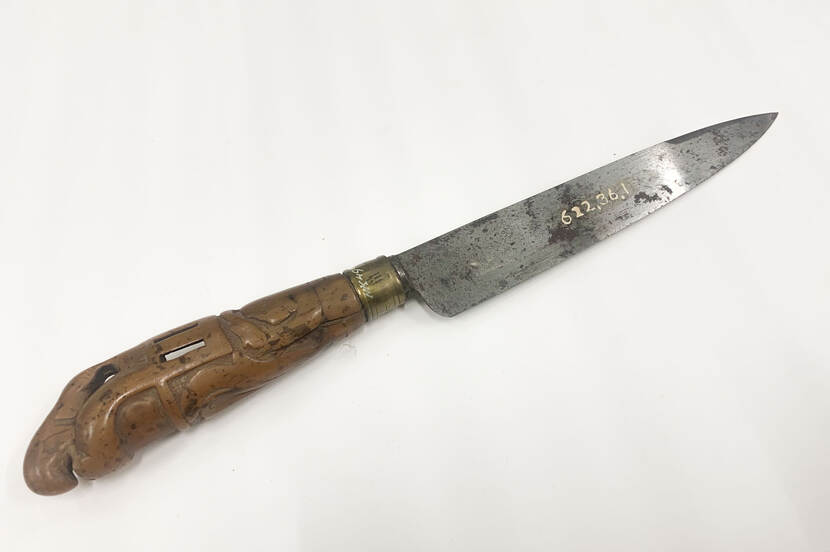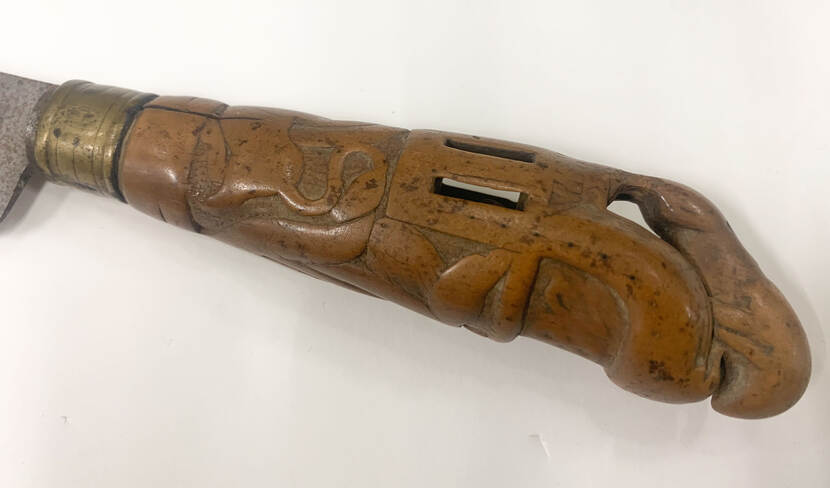In pursuit of provenance: who owned this traditional Zealand pocket knife?
Weblog
In the In pursuit of provenance blogs series, we focus each month on a different object from the Netherlands Art Property (Nederlands Kunstbezit, NK) collection, which is the subject of extensive provenance research. This collection is made up of objects that were returned to the Netherlands after the Second World War. They include paintings, works on paper and applied art, such as furniture and ceramics. By giving this research renewed impetus, we hope to be able to identify additional information on provenance. This month: a characteristic Zealand farmer’s pocket knife. Do you happen to have more information about its production and provenance?

An everyday showpiece
In the 19th century, farmers in the Zealand (Netherlands) countryside would always carry this type of knife as a regular part of their traditional costume. The palmwood hilts with decorative carving were clearly visible above the edge of their trousers and were deliberately used to show off. They were also everyday utensils used by the farmers on a daily basis for all kinds of things: from cutting rope to buttering bread or scraping mud from the shoes.
The former owner of this traditional paeremes, or ‘horse knife’, that we are investigating obviously used it a lot because the wooden hilt is worn. However, it is still possible to see a flower stem on the ventral side, crowned with a climbing lion. Traditional knife carvers in Zealand carved detailed scenes in the wood. At the start of the 19th century, many had biblical scenes carved onto them, and the hilts were later decorated with images of horses and agricultural equipment. Underneath the pommel of the knife, there are gaps that form a hollow cage with a rattling ball loose inside it: one of the characteristics that makes it so typical of Zealand. The hilt also has the year 1850 carved on it, which, together with the name on the blade, could be a clue to its original owner. It is possible to make out the name E. Quincke on the steel blade of this paeremes.

The provenance research
When we started our research, it was already known that the knife had been returned to the Netherlands after the Second World War from the Klingenmuseum in Solingen, Germany – a museum that still exists and has a large collection of weaponry and cutlery. Exactly how the knife found its way to the museum was unknown, but it featured on a list of objects that the museum had purchased in the Netherlands in 1942 and 1943. The Klingenmuseum investigated its own archives on our behalf and was able to tell us that it had bought it in 1943 from C.J.J. Weegenaar, an antique dealer based at Frederikstraat in The Hague. We were unable to find any information about this antique dealer’s purchases or sales during the Second World War. The paeremes is currently in the RCE National Collection.
We have also taken a close look at the external features of the knife. This is because every knife carver in Zealand had his own unique style. We know from Frans Dingemanse, expert in the design of Zealand hilts and himself a carver of knives of this kind, that it must be made by someone from Zuid-Beveland because the use of the lion as the pommel for the knife developed in that area. The original blade must have been worn or broken, because the existing blade and spacer ring are not typical of knives from Zealand. The owner may have inherited his father or grandfather’s worn paeremes and was reluctant to discard it because of the memories it held. A new blade may have been fitted onto it for that reason.
Help wanted
In our search for the provenance of this farmer's pocket knife from Zealand we are attempting to discover who the possible owner could have been. Who was E. Quincke and does this name have a connection with the year 1850? And from whom did the antique dealer C.J.J. Weegenaar buy the knife? If you happen to know more about this knife or have any information that could help us in our quest, please contact us at: restitutie@cultureelerfgoed.nl.
This blog was written by Silja de Vilder Coombs and Laurie Gnade, junior provenance researchers, WW II Cultural Goods Restitution.
Update april 2023
After the publication of this blog, there appeared to be great interest in the paeremes from the NK collection, especially in Zealand. For example, one of the provenance researchers was interviewed on the radio program Goedemorgen Zeeland and paeremes expert Frans Dingemanse also shared his knowledge on NPO Radio 5. Following these radio interviews, a number of people shared more details with us about this form of Zealand folk art. For example, someone said that farm workers used these knives to cut ropes, we learned that it was tradition for farm boys to receive a paeremes around the age of 15, and that a paeremes in Zealand are passed on from generation to generation. There turned out to be a lot of curiosity about the person E. Quincke, but we are still waiting for the tip that will help us find the maker and original owner of the knife.
---